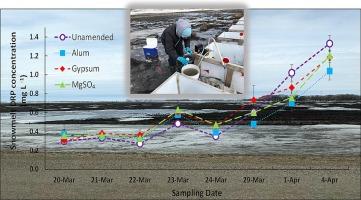Residual benefits of alum, gypsum, and magnesium sulfate amendments in reducing phosphorus losses to snowmelt runoff
IF 5.4
1区 农林科学
Q1 GEOSCIENCES, MULTIDISCIPLINARY
引用次数: 0
Abstract
Phosphorus (P) in snowmelt runoff from agricultural fields across the Canadian prairies is a major source of pollution to freshwater bodies. Soil amendments have previously been shown to reduce P loss from soils in laboratory-simulated and field snowmelt studies; however, their residual benefits beyond one snowmelt event are unknown. This study examined the effectiveness of alum (Al2(SO4)3·18H2O), gypsum (CaSO4·2H2O), and magnesium sulfate (MgSO4·7H2O) in reducing P losses to snowmelt 18 months after amendment application. The study was conducted on a silty clay loam soil in Manitoba. Amendments were applied in the fall of 2020 at a rate of 2.5 Mg/ha. The amended treatments, including an unamended control with four replicates, were arranged in a randomized complete block design. Daily snowmelt was collected from each field plot in the spring of 2022, volume recorded, and analyzed for dissolved reactive P (DRP), pH, and cation concentrations. Snowmelt DRP concentrations increased over the sampling period regardless of treatment, with higher concentrations after the soils had thawed. In the latter days of sampling, the field plots that received amendments had snowmelt DRP concentrations 9 – 31 % lower than the control treatment, but the differences were not statistically significant. Snowmelt DRP loads showed a significant positive relationship with snowmelt volume but not with DRP concentration, suggesting that DRP load is largely controlled by the snowmelt volume rather than the snowmelt DRP concentration. Our results suggest that the amendments applied at this rate were ineffective in reducing DRP loads 18 months after application.

明矾、石膏和硫酸镁添加剂在减少融雪径流磷损失方面的剩余效益
加拿大大草原农田融雪径流中的磷(P)是淡水水体的主要污染源。在实验室模拟和实地融雪研究中,土壤改良剂曾被证明可以减少土壤中磷的流失;但是,它们在一次融雪事件之后的剩余效益尚不清楚。本研究考察了明矾(Al2(SO4)3-18H2O)、石膏(CaSO4-2H2O)和硫酸镁(MgSO4-7H2O)在施用土壤改良剂 18 个月后减少融雪中 P 损失的效果。这项研究是在马尼托巴省的淤泥质粘壤土上进行的。添加剂于 2020 年秋季施用,添加量为 2.5 兆克/公顷。施用过改良剂的处理(包括未施用改良剂的对照组,共四个重复)采用随机完全区组设计。2022 年春季,从每个田块收集每日融雪,记录融雪量,并分析溶解性活性磷(DRP)、pH 值和阳离子浓度。在采样期间,无论采用哪种处理方法,融雪水中的 DRP 浓度都在增加,土壤解冻后浓度更高。在取样的后几天,接受了改良剂的田块的融雪 DRP 浓度比对照处理低 9 - 31%,但差异在统计学上并不显著。融雪 DRP 负荷与融雪量呈显著正相关,但与 DRP 浓度无关,这表明 DRP 负荷主要受融雪量而非融雪 DRP 浓度控制。我们的研究结果表明,在施用添加剂 18 个月后,以这种比例施用的添加剂无法有效降低 DRP 负荷。
本文章由计算机程序翻译,如有差异,请以英文原文为准。
求助全文
约1分钟内获得全文
求助全文
来源期刊

Catena
环境科学-地球科学综合
CiteScore
10.50
自引率
9.70%
发文量
816
审稿时长
54 days
期刊介绍:
Catena publishes papers describing original field and laboratory investigations and reviews on geoecology and landscape evolution with emphasis on interdisciplinary aspects of soil science, hydrology and geomorphology. It aims to disseminate new knowledge and foster better understanding of the physical environment, of evolutionary sequences that have resulted in past and current landscapes, and of the natural processes that are likely to determine the fate of our terrestrial environment.
Papers within any one of the above topics are welcome provided they are of sufficiently wide interest and relevance.
 求助内容:
求助内容: 应助结果提醒方式:
应助结果提醒方式:


